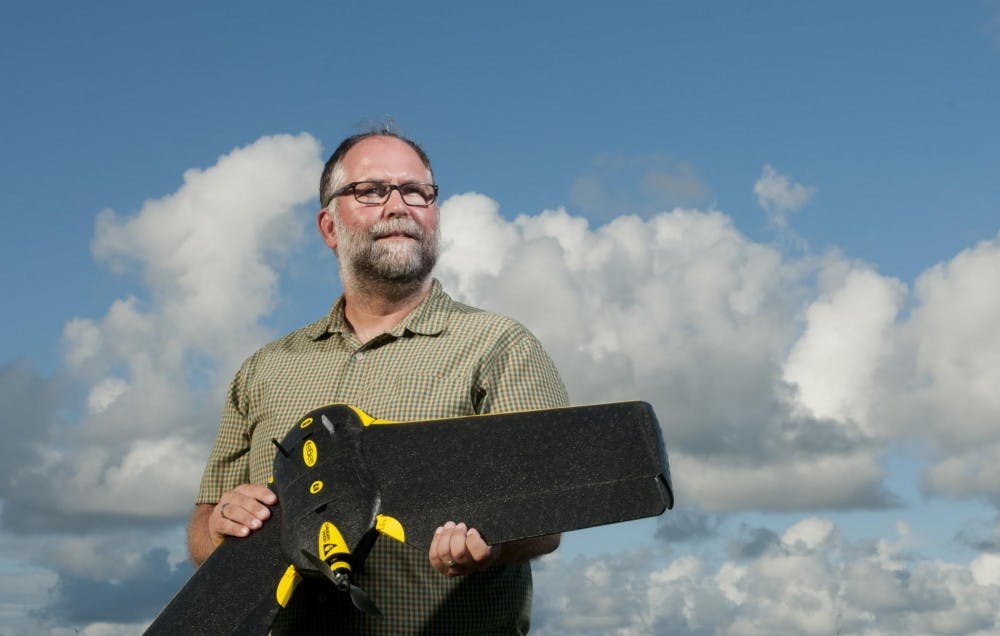The Duke Marine Lab is taking to the skies to study marine ecology and endangered species.
After receiving Federal Aviation Administration approval Friday, the recently-opened Marine Conservation Ecology Unmanned Systems Facility aims to use unmanned aerial vehicle technology—or drones—to gather data more efficiently than ever before. With the approval, the laboratory can now pilot drones stateside in addition to its already-sponsored missions abroad. The Beaufort, N.C., facility flew operational missions in August along with researchers at the University of North Carolina at Chapel Hill in Costa Rica to track the nesting patterns of endangered sea turtles.
“We’re interested in using these systems to go out and count animals, to study coastal habitats and obtain coastal imagery, to see how coastlines might be eroding, as well as for emergency response to maritime emergencies,” said David Johnston, the drone facility’s executive director and assistant professor of the practice of marine conservation ecology at The Nicholas School of the Environment.
Drone technology opens up new areas of research that were previously inaccessible, Johnston explained. He added that using drones is safer than helicopters or planes—which researchers have typically used in the past.
Researchers will also be able to get drones in the air on shorter notice and more frequently compared to the time it takes to get a plane up-and-running, said Julian Dale, lead engineer for the facility. He noted that drones offer access to lower altitudes and tighter spaces and are particularly useful when studying endangered species, because loud planes or helicopters risk altering the animals’ behavior.
The FAA has not yet finalized regulations specific to UAVs, so in order to use one stateside, the facility had to apply for an exemption from traditional manned aircraft rules.
Even with the exemption, the facility will only be able to use drones for narrow purposes, Johnston added. They are required to fly missions below 400 feet, operate during the day and must maintain line-of-sight with the drone during the entirety of the mission.
Once the FAA finalizes its “Small [Unmanned Aircraft Systems] Rule”—which FAA spokesperson Les Dorr wrote via email is likely to happen in about a year—those operating drones from the ground at the facility will be able to take an “aeronautical knowledge test” and become certified by the FAA as UAV pilots, Johnston explained, instead of needing the exemption.
North Carolina also requires commercial public agency operators to pass a test in order to operate drones in the state, said Bobby Walston, aviation director at the North Carolina Department of Transportation.
Although the facility has not yet been able to test out the technology locally, they have seen significant results abroad through their work in Costa Rica.
Researchers have already reached out to the facility asking to collaborate on usage of their drone technology, and Johnston expects to get those projects up-and-running soon. The facility currently partners with senseFly, a Swiss firm, in order to produce its drones, but Johnston hopes that the facility will continue to grow more independent in years to come.
Apart from the research potential of using drones, Dale added that the facility plans to sponsor educational content—both at Duke and at nearby East Carteret High School.
The Duke course is anticipated to begin next summer and be open to undergraduates, Johnston said. The curriculum would include information about federal and state regulations, data analysis and workflow, mission design and potentially drone construction.
Johnston noted that there are multiple facilities around the country doing drone education, but that they tend to be primarily focused on agriculture and terrestrial environments rather than the marine research happening at the Marine Lab.
“It’s very different to fly over the ocean than it is over a cornfield,” Johnston said. “We want to get students background on oceanography and the behavior of marine animals, and that’s going to be an important part of the curriculum.”
As a supplement to the course curriculum, Sidney McLaurin, an MBA student at the Fuqua School, is working with the facility to help market students’ drone-usage skills to outside commercial entities, such as surveying companies.
The partnership with East Carteret High School—which includes an aviation club at the school and the use of drone technology in advance placement classes—came out of an attempt to mitigate the often-negative public perception of drones, Dale said. The club will try to get students better acquainted with UAV systems and promote the safe use of drone technology.
“We want to be able to train the next-generation of people who will be able to go out into the workforce and use these tools,” Johnston said.
Get The Chronicle straight to your inbox
Signup for our weekly newsletter. Cancel at any time.

